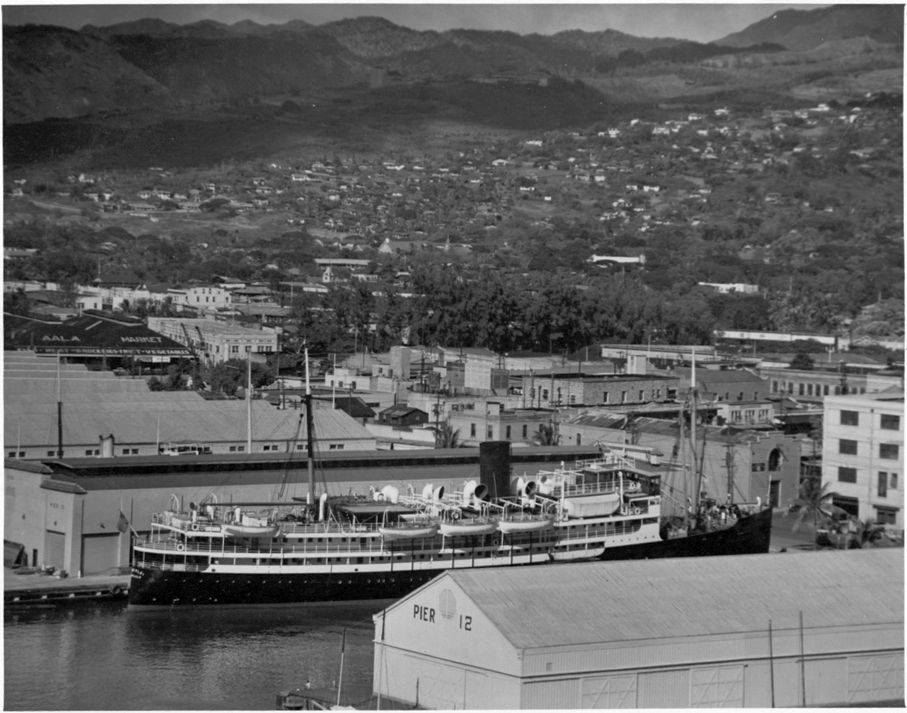James Robinson came to the islands from London, his birthplace, arriving here in 1820, before the first missionaries (while rounding Cape Horn his ship passed the “Thaddeus,” which was bringing the first missionaries from New England.)
He was carpenter on the whaling ship “Hermes.” In 1822, sailing from Honolulu for Japan the Hermes was wrecked on the reef of Holoikauaua (what is now referred to as Pearl and Hermes.)
This seeming disaster turned into a new industry for Honolulu and proved to be the foundation of his subsequent business and of his fortune.
The combined crews (totaling 57) made it safely to one of the small islands and were castaway for months with what meager provisions they could salvage.
He and the crew built a small schooner (the Deliverance) from the wreckage and the survivors of the wreck sailed back to Honolulu to remain permanently.
After his arrival, Robinson was befriended by Kamehameha II and John Young. He and a ship-mate, Robert Lawrence (a cooper (barrel maker,)) sold the Deliverance for $2,000 and found employment in repairing schooners owned by the king and chiefs.
They received the assistance of Kamehameha II and, in 1827, established their shipyard in Honolulu harbor at Pākākā, or “the Point,” on land obtained from Kalanimoku. They were later joined as a full partner by James Holt, “a very respectable man from Boston.”
In 1840, the Polynesian commended the partners and their shipyard: “Honest, industrious, economical, temperate, and intelligent, they are living illustrations of what these virtues can secure to men. …”
“Their yard is situated in the most convenient part of the harbor has a stone butment and where two vessels of six hundred tons burthen can be berthed, hove out, and undergo repairs at one and the same time. There is fourteen feet of water along side of the butment.”
“The proprietors generally keep on hand all kinds of material for repairing vessels. Also those things requisite for heaving out, such as blocks, falls, etc. On the establishment are fourteen excellent workmen, among whom are Ship Carpenters, Caulkers and Gravers, Ship Joiners, Block-makers, Spar-makers, Boatbuilders, etc.”
In mid-September 1830, Joseph Elliott moved to The Point to open a hotel with Robinson. Lawrence and Holt, Robinson’s partners, appear to have specialized in the hotel and liquor business, which also featured a boarding house. The Shipyard Hotel had the advantage of being a “first chance – last chance” operation.
Years rolled on, and the firm of James Robinson & Co. (including Robert Lawrence and Mr. Holt) was a significant success and carried on a business that employed a large number of ship-carpenters and caulkers. More whaling ships were repaired at their establishment than at any other in the Pacific.
This partnership lasted until 1868, when Mr. Lawrence died. For many years their building was one of the sights of the town, being decorated with the figurehead from an old vessel.
Robinson became so wealthy; reportedly, he lent substantial funds to the Hawaiian government during the 1850s and maintained a close relationship with the kingdom’s leaders until his death in 1876.
Hawaiians called him Kimo (James) Pakaka as Honolulu Harbor grew up around his shipyard.
In 1843, James Robinson married Rebecca Prever; they had eight children: Mark, Mary, Victoria, Bathsheba, Matilda, Annie, Lucy and John.
Mr. Robinson died at his residence in Nuʻuanu valley August 8, 1876. However, his legacy lived on through his children.
His descendants became a well-known island family and his fortune founded the Robinson Estate. His son, Mark, was a member of Queen Liliʻuokalani’s cabinet (Minister of Foreign Affairs) during the chaotic last months of the monarchy as factional battles separated the royal government. He was a founder of First National Bank of Hawai’i and First American Savings.
His daughter Lucy married a McWayne (apparently, Robinson’s ship facility eventually became McWayne Marine Supply at Kewalo Basin – some old-timers may remember that later name.)
Daughter Victoria married a Ward. Their residence was known as Old Plantation, and included the current site of the Neil F. Blaisdell Center. Her estate, Victoria Ward Ltd, had other significant holdings in Kakaʻako.
Daughter Mary married a Foster. Her husband Thomas Foster was an initial organizer of the Inter-Island Steam Navigation Company. That company founded a subsidiary, Inter-Island Airways, that later changed its name to Hawaiian Airlines.
Foster had also purchased the estate of the renowned botanist William Hillebrand, which was bequeathed to the city as Foster Botanical Garden at the death of his wife Mary.
The image shows Honolulu Harbor in 1854. The Robinson facilities are on the right hand side – to the left of the Fort wall (you can see a ship being repaired at the shore.)





















































